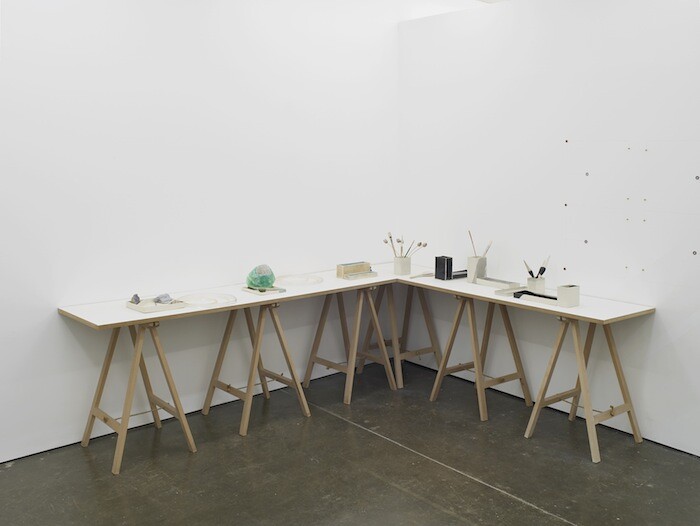Categories
Subjects
Authors
Artists
Venues
Locations
Calendar
Filter
Done
May 18, 2017 – Review
Christina Mackie’s “Drift Rust”
Patrick Langley

Christina Mackie’s installations have an instinctive and provisional feel about them. They present the viewer with arrays of disparate objects, arranged on trestle tables, walls, and shelves, assembled according to a spontaneous logic of correspondence and juxtaposition. Mackie refers to this aspect of her work as “trestle art.” Wolfgang Tillmans’ tables and vitrines (such as truth study centre, Tate, 2017), Camille Henrot’s The Pale Fox (2014), and Portia Munson’s Pink Project: Table (1994) are a few notable examples of the genre. Recalling the Surrealist tradition of assemblage and the more recent trend of “archive art,” in which artists collect and compile existing imagery and information, “trestle art” positions the artist as curator or analyst. Filtration and distillation take precedence over production. Objects, selected according to fixed and often idiosyncratic criteria, are brought into conversation with one another.
As Hal Foster has observed, “archival artists seek to make historical information, often lost or displaced, physically present.” One obvious difference between Mackie’s works and those of other “trestle” and “archive” artists is that she makes almost all of the objects herself. A notable example in “Drift Rust,” Mackie’s solo exhibition at London’s Herald Street (the show is described as an installation in the …
January 24, 2011 – Review
Peter Coffin’s "Cosmolology + 1" at Herald St, London
Anna Gritz

There is something theatrical about Peter Coffin’s recent exhibition at Herald St. The scene is set for what appears to be a science-play consistent of three main set components: clouds, hanging plants, and neon wires—backdrops, curtains, and stage lighting. The gallery/stage functions as a cosmic model, or rather a rehearsal of the cosmic process as Antonin Artaud would call it—the study of the study of the study of the Cosmos.
Like in any exploration, the subject reveals itself bit-by-bit, reliant on the point of view of the visitor, which slowly takes shape through the act of conquering space. That is, the visitor turned actor performs this play collectively with the works on view. In the first room, in the midst of an arrangement of seven thin neon tubes that wriggle in erratic, vertical lines from ceiling to floor, Untitled (Lines), 2011, look like jungle lianas, each flickering in a different color taken from the Newtonian color spectrum. Yet there is something materially unstable and slightly unnerving about these solid glass tubes and the way they reflect every move in a multifarious shadow play onto the gallery walls. Whoever meanders through the colonnade of light is engulfed in a light therapy of …